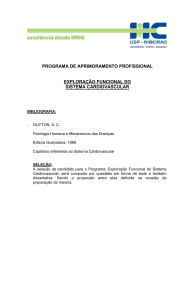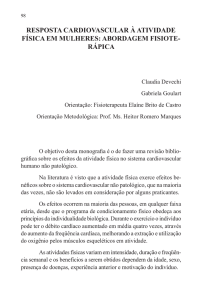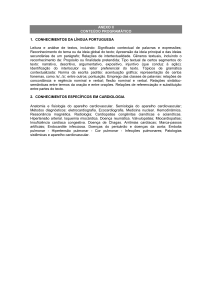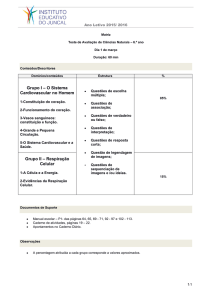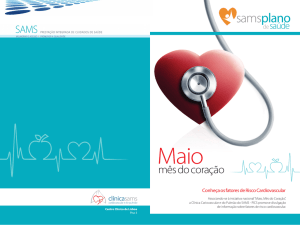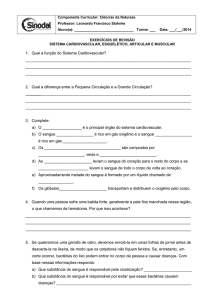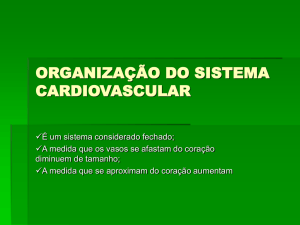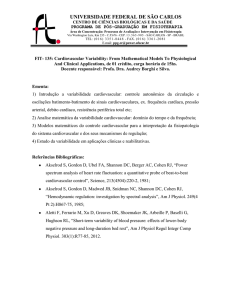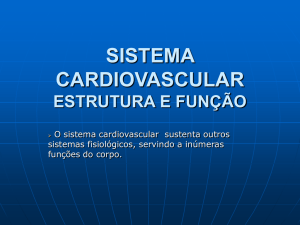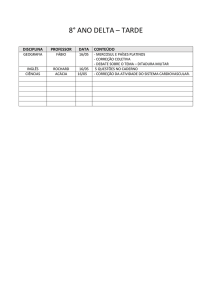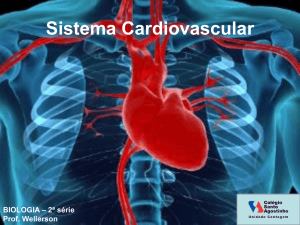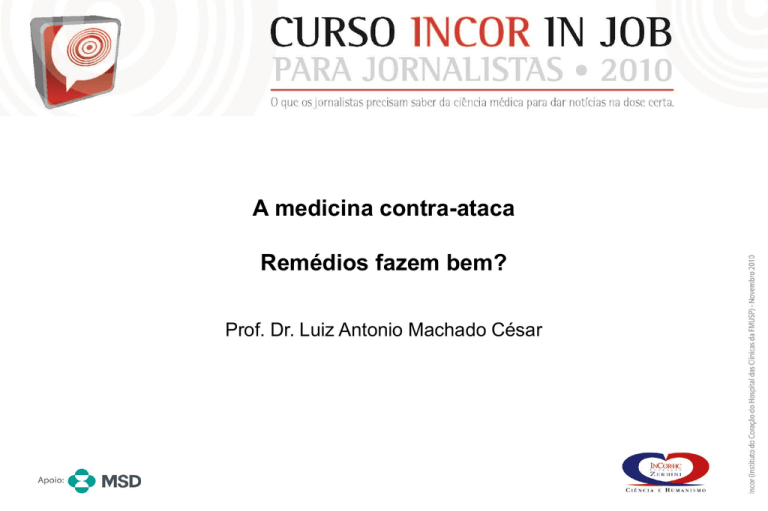
A medicina contra-ataca
Remédios fazem bem?
Prof. Dr. Luiz Antonio Machado César
ROTEIRO
1.
2.
3.
4.
5.
6.
7.
Como são criados e desenvolvidos os medicamentos;
O desenvolvimento de medicamentos novos; e como entender os similares
e os genéricos. Essa indústria é diferente de outras?
Quais os princípios envolvidos na ação dos medicamentos;
Sempre sabemos como funcionam exatamente? Riscos e benefícios do
uso do medicamento; o peso que pesa na consciência do médico.
Qual o trajeto até os medicamentos chegarem ao mercado. Como eles são
retirados do mercado;
A importância da farmacovigilância, a necessidade do retorno de
informação dos médicos e a interação medicamentosa
Síntese do módulo: o sucesso da terapêutica medicamentosa, ou
farmacoterapia, depende do desenvolvimento de medicamentos de
qualidade, eficazes e seguros. Depende também do uso racional dos
medicamentos. Neste módulo serão abordados os aspectos fundamentais
sobre a origem e os tipos de medicamentos disponíveis no mercado, seu
mecanismo de ação, interações potenciais, além dos riscos e benefícios
para os consumidores.
2. DE ONDE VEM?
• Fauna e Flora são a base:
– Efeitos avaliados em testes clínicos
– Isolamento do princípio ativo
– Pesquisa de mecanismo de ação
• Descobrimentos em laboratório de:
– Receptores (proteínas), canais iônicos
– Pesquisa de mecanismo de ação
– Princípios ativos avaliados
Um
de
200-400
4. COMO FUNCIONAM?
• Bloqueiam canais iônicos
– Antiarritmicos
– Antidiabéticos
• Antagonizam receptores
– Antihipertensivos, anticoagulantes
• Alteram receptores (combinando com proteínas)
• Bloqueiam enzima
– Antibióticos, anticancerígenos
CANAIS E RECEPTORES
-receptor
Receptor muscarinico
Canal f
Canal de cálcio T
Célula do Nó Sinusal
Canal de cálcio L
Corrente If
Canal de potássio
CANAIS
DO BENEFÍCIO À TOXICIDADE
•Digoxina tem dose terapêutica que pode ser tóxica.
•Cumarínico tem dose terapêutica muito próxima daquela da
janela terapêutica, portanto da inficácia também
Efeito
nenhum
Tome um comprimido 2ª, 4ª , 6ª,
E meio nas quintas e sábados e não tome
Efeito
no ideal
domingo......DEPOIS
DE UMA SEMANA
efeito
AGORA meio tóxico
2ª 4ª 6ª um no sábado e
quinta e domingo
Experiência em animais – camundongos, coelhos, cães para
avaliar efeitos e toxicologia (doses tóxicas). DE CENTENAS
5. FASES DOS ESTUDOS
1a
Fase 1 humanos (uma a duas dezenas)- Teste em voluntários
para efeito e toxicologia – geralmente pagam-se prisioneiros
(EUA).
2a
Fase 2 humanos – Testes em voluntários para eficácia de dose e
segurança.
5a
Fase 3 humanos- Estudos iniciais para confirmar eficácia e
depois estudos para reconfirmar e completar segurança em
grande escala. PARA UM FÁRMACO
5. DILEMAS DOS MÉDICOS
Após estudos iniciais de fase 3, são liberados para a comercialização.
Raramente, após fase 2 (casos de antiproliferativos, antineoplásicos)
No passado estudos com dezenas de pacientes. Hoje, centenas.
Público alvo:
1-médicos
2- leigos
Comprovação
de eficácia a
longo prazo: Reconfirmação
novos estudos de segurança a
de fase 3
longo prazo.
(milhares) e os
de fase 4.
5 e 6. RETIRADA DE UM FÁRMACO DA COMERCIALIZAÇÃO
•
•
•
Farmacovigilância aponta efeitos colaterais em maior número e mais
graves do que os observados na fase 3.
Reanálise dos dados. Metanálises.
Discussões nos orgãos reguladores
Talidominda, fen-fen, mibefradil, cerivastatina, rosiglitazona, etc.
sibutramina não aumenta risco de doença cardiovascular,
dizem especialistas
Publicidade
JULIANA VINES
ENVIADA ESPECIAL A GRAMADO (RS)
A ingestão de sibutramina, mesmo a longo prazo, não aumenta o risco de infarto ou AVC em pacientes sem
histórico de doenças cardiovasculares.
A conclusão foi divulgada na última quinta-feira na revista "New England Journal of Medicine". "Isso prova que a
bula do medicamento sempre esteve certa e que as conclusões anteriores eram precipitadas", disse o
endocrinologista Walmir Coutinho durante o 29º Congresso de Endocrinologia e Metabologia esta semana, em
Gramado.
O estudo foi realizado com 10.000 pessoas durante seis anos e teve a participação de oito países, incluindo o
Brasil. Constatou-se que pacientes com doenças cardiovasculares tiveram um aumento de 16% no risco de ter
infarto ou AVC não fatal.
"Essa sempre foi uma contraindicação da droga", complementa Coutinho. Não houve relatos de pacientes com
problemas psicológicos, como dependência ou depressão.
No início do ano, a Agência Europeia de Medicamentos (Emea) proibiu a venda de sibutramina depois da
divulgação de alguns dados parciais do mesmo estudo. Em março, a Anvisa tornou obrigatória a apresentação
de receita azul para a venda do medicamento. Em julho, determinou que a dose máxima a ser receitada não
deve passar de 15 miligramas diárias.
"Houve uma interpretação errada dos resultados. Não é necessário enquadrar o produto como uma droga
capaz de causar dependência. Isso só dificulta o tratamento e afasta pacientes", afirma Ricardo Meirelles,
presidente da Sbem (Sociedade Brasileira de Endocrinologia e Metabologia).
NEW ENGLAND JOURNAL OF MEDICINE
Original Article
VER ARTIGO ORIGINAL
Effect of Sibutramine on Cardiovascular Outcomes in Overweight and Obese Subjects
W. Philip T. James, M.D., D.Sc., Ian D. Caterson, M.D., Ph.D., Walmir Coutinho, M.D., D.Sc., Nick Finer, M.B., B.S., Luc F. Van Gaal, M.D., Ph.D., Aldo P.
Maggioni, M.D., Christian Torp-Pedersen, M.D., Ph.D., Arya M. Sharma, M.D., Ph.D., Gillian M. Shepherd, B.Sc., Richard A. Rode, Ph.D., and Cheryl L. Renz,
M.D. for the SCOUT Investigators
N Engl J Med 2010; 363:905-917September 2, 2010
Background
The long-term effects of sibutramine treatment on the rates of cardiovascular
events
and cardiovascular death among subjects at high cardiovascular risk have not
NECESSIDADE DE
TER DOENÇA
CORONARIANA ou ACIDENTE
been established.
VASCULAR CEREBRAL ou DOENÇA
Methods
PERIFÉRICA.
OU DIABETES
HAS,preexisting
ou
We enrolled in our study 10,744 overweight or obese subjects, 55
years of age
or older, Ewith
cardiovascular disease, type 2 diabetes mellitus, or both to
LIPIDES
AUMENTADOS
ou
FUMANTE
assess the cardiovascular consequences of weight management with and without sibutramine in subjects at high risk for cardiovascular events. All the subjects
ou DOENÇA program
RENAL DOduring
DIABÉTICO)
received sibutramine in addition to participating in a weight-management
a 6-week, single-blind, lead-in period, after which 9804 subjects
underwent random assignment in a double-blind fashion to sibutramine (4906 subjects) or placebo (4898 subjects). The primary end point was the time from
randomization to the first occurrence of a primary outcome event (nonfatal myocardial infarction, nonfatal stroke, resuscitation after cardiac arrest, or cardiovascular
death).
Results
The mean duration of treatment was 3.4 years. The mean weight loss during the lead-in period was 2.6 kg; after randomization, the subjects in the sibutramine group
achieved and maintained further weight reduction (mean, 1.7 kg). The mean blood pressure decreased in both groups, with greater reductions in the placebo group
than in the sibutramine group (mean difference, 1.2/1.4 mm Hg). The risk of a primary outcome event was 11.4% in the sibutramine group as compared with 10.0%
in the placebo group (hazard ratio, 1.16; 95% confidence interval [CI], 1.03 to 1.31; P=0.02). The rates of nonfatal myocardial infarction and nonfatal stroke were
4.1% and 2.6% in the sibutramine group and 3.2% and 1.9% in the placebo group, respectively (hazard ratio for nonfatal myocardial infarction, 1.28; 95% CI, 1.04
to 1.57; P=0.02; hazard ratio for nonfatal stroke, 1.36; 95% CI, 1.04 to 1.77; P=0.03). The rates of cardiovascular death and death from any cause were not
increased.
Conclusions
Subjects with preexisting cardiovascular conditions who were receiving long-term sibutramine treatment had
an increased risk of nonfatal myocardial infarction and nonfatal stroke but not of cardiovascular death or
death from any cause. (Funded by Abbott; ClinicalTrials.gov number, NCT00234832.)
NEW ENGLAND JOURNAL OF MEDICINE
Original Article
Effect of Sibutramine on Cardiovascular Outcomes in Overweight and Obese Subjects
W. Philip T. James, M.D., D.Sc., Ian D. Caterson, M.D., Ph.D., Walmir Coutinho, M.D., D.Sc., Nick Finer, M.B., B.S., Luc F. Van Gaal, M.D., Ph.D.,
Aldo P. Maggioni, M.D., Christian Torp-Pedersen, M.D., Ph.D., Arya M. Sharma, M.D., Ph.D., Gillian M. Shepherd, B.Sc., Richard A. Rode, Ph.D., and
Cheryl L. Renz, M.D. for the SCOUT Investigators
N Engl J Med 2010; 363:905-917September 2, 2010
Background
The long-term effects of sibutramine treatment on the rates of cardiovascular events and cardiovascular death among subjects at high cardiovascular
risk have not been established.
Methods
We enrolled in our study 10,744 overweight or obese subjects, 55 years of age or older, with preexisting cardiovascular disease, type 2 diabetes
mellitus, or both to assess the cardiovascular consequences of weight management with and without sibutramine in subjects at high risk for
cardiovascular events. All the subjects received sibutramine in addition to participating in a weight-management program during a 6-week, singleblind, lead-in period, after which 9804 subjects underwent random assignment in a double-blind fashion to sibutramine (4906 subjects) or placebo
(4898 subjects). The primary end point was the time from randomization to the first occurrence of a primary outcome event (nonfatal myocardial
infarction, nonfatal stroke, resuscitation after cardiac arrest, or cardiovascular death).
Results
The mean duration of treatment was 3.4 years. The mean weight loss during the lead-in period was 2.6 kg; after randomization, the subjects in the
sibutramine group achieved and maintained further weight reduction (mean, 1.7 kg). The mean blood pressure decreased in both groups, with greater
reductions in the placebo group than in the sibutramine group (mean difference, 1.2/1.4 mm Hg). The risk of a primary outcome event was 11.4% in
the sibutramine group as compared with 10.0% in the placebo group (hazard ratio, 1.16; 95% confidence interval [CI], 1.03 to 1.31; P=0.02). The rates
of nonfatal myocardial infarction and nonfatal stroke were 4.1% and 2.6% in the sibutramine group and 3.2% and 1.9% in the placebo group,
respectively (hazard ratio for nonfatal myocardial infarction, 1.28; 95% CI, 1.04 to 1.57; P=0.02; hazard ratio for nonfatal stroke, 1.36; 95% CI, 1.04 to
1.77; P=0.03). The rates of cardiovascular death and death from any cause were not increased.
Conclusions
Subjects with preexisting cardiovascular conditions who were receiving long-term sibutramine treatment had an
increased risk of nonfatal myocardial infarction and nonfatal stroke but not of cardiovascular death or death from
any cause. (Funded by Abbott; ClinicalTrials.gov number, NCT00234832.)
• ?????????????????????????????
MEDICINA BASEADA EM EVIDÊNCIAS
1. Sempre decidimos com evidências.
2. Na maioria das vezes as evidências são poucas.
3. Às vezes essa são incontestáveis.
4. Evidência para o médico? Para a indústria? Ou para os
financiadores da saúde?
Statins and All-Cause Mortality in High-Risk Primary Prevention
A Meta-analysis of 11 Randomized Controlled Trials Involving 65 229 Participants
Kausik K. Ray, MD, MPhil, FACC, FESC; Sreenivasa Rao Kondapally Seshasai, MD, MPhil; Sebhat Erqou, MD, MPhil, PhD; Peter Sever, PhD,
FRCP, FESC; J. Wouter Jukema, MD, PhD; Ian Ford, PhD; Naveed Sattar, FRCPath
Arch Intern Med. 2010;170(12):1024-1031.
ABSTRACT
Background Statins have been shown to reduce the risk of all-cause mortality among individuals with clinical history of coronary heart disease.
However, it remains uncertain whether statins have similar mortality benefit in a high-risk primary prevention setting. Notably, all systematic reviews to
date included trials that in part incorporated participants with prior cardiovascular disease (CVD) at baseline. Our objective was to reliably determine if
statin therapy reduces all-cause mortality among intermediate to high-risk individuals without a history of CVD.
Data Sources Trials were identified through computerized literature searches of MEDLINE and Cochrane databases (January 1970-May 2009) using
terms related to statins, clinical trials, and cardiovascular end points and through bibliographies of retrieved studies.
Study Selection Prospective, randomized controlled trials of statin therapy performed in individuals free from CVD at baseline and that reported
details, or could supply data, on all-cause mortality.
Data Extraction Relevant data including the number of patients randomized, mean duration of follow-up, and the number of incident deaths were
obtained from the principal publication or by correspondence with the investigators.
Data Synthesis Data were combined from 11 studies and effect estimates were pooled using a random-effects model meta-analysis, with
heterogeneity assessed with the I2 statistic. Data were available on 65 229 participants followed for approximately 244 000 person-years, during
which 2793 deaths occurred. The use of statins in this high-risk primary prevention setting was not associated with a statistically significant reduction
(risk ratio, 0.91; 95% confidence interval, 0.83-1.01) in the risk of all-cause mortality. There was no statistical evidence of heterogeneity among
studies (I2 = 23%; 95% confidence interval, 0%-61% [P = .23]).
Conclusion This literature-based meta-analysis did not find evidence for the benefit of statin
therapy on all-cause mortality in a high-risk primary prevention set-up.
Taxa de mortes em cada grupo (por 1000 pessoas-anos, %)
Relationship between baseline age of participants and mortality rates in 11
randomized trials of statins among participants without prior coronary heart
disease at baseline
Idade em anos, no basal
Ray, K. K. et al. Arch Intern Med 2010;170:1024-1031.
Copyright restrictions may apply.

